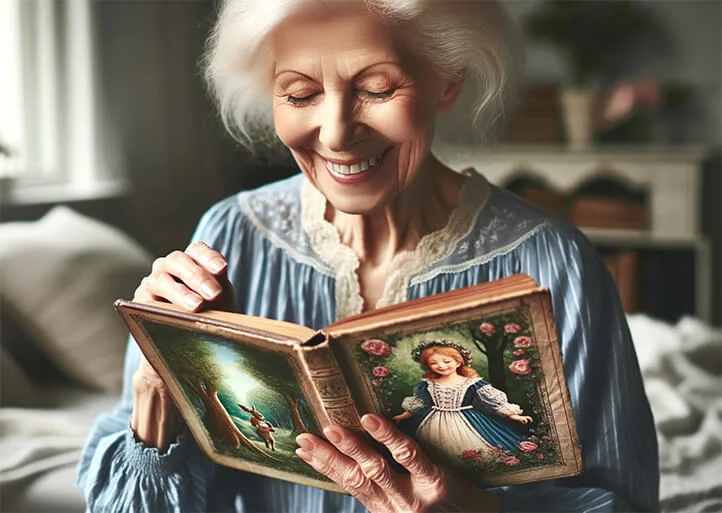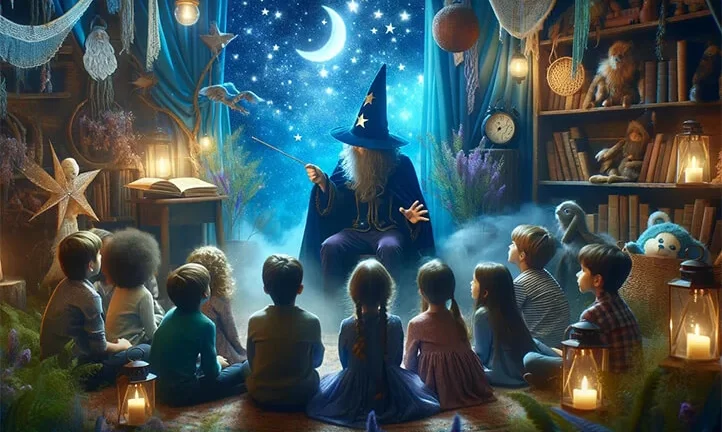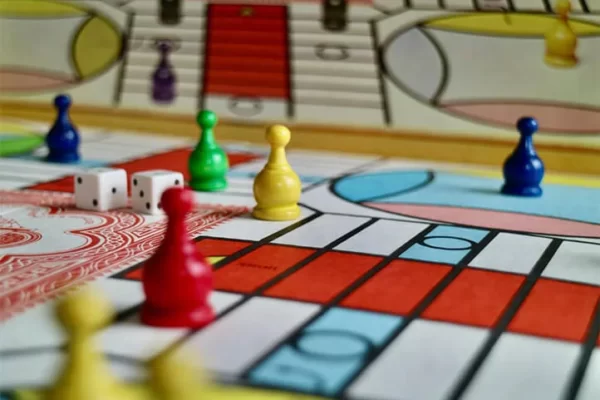Fairytale therapy is a method in psychotherapy where fairy tales are used as the primary tool to address people’s emotional and psychological problems. This method relies on the rich symbolism and profound archetypal images found in fairy tales, helping clients understand and process their internal conflicts, fears, and experiences.
In fairytale therapy, fairy tales are used as a means to achieve various goals, from developing emotional intelligence and social skills to healing trauma and resolving internal conflicts. The tales can be traditional or created specifically for individual cases. Through the process of identifying with the characters in the tales and their experiences, clients can find solutions to their problems, as well as receive support and inspiration for personal growth and development.
Fairytale therapy is a unique approach in psychotherapy, combining elements of art, folk wisdom, and psychological techniques to support and heal individuals.

A Brief History of Fairytale Therapy
Fairytale therapy, as a formalized method of psychotherapy, began to develop in the mid-20th century, although the use of fairy tales for teaching, healing, and imparting wisdom has much older roots.
Since ancient times, fairy tales have been used as a means of conveying knowledge, moral lessons, and cultural values. They were an integral part of oral folk art, helping people understand and make sense of the world around them.
Modern fairytale therapy began to take shape in the second half of the 20th century. Psychoanalysts like Sigmund Freud and Carl Jung made significant contributions to understanding the symbolism and archetypes found in fairy tales. Jung, in particular, emphasized the importance of archetypes and the collective unconscious, which became the foundation for using fairy tales in therapy.
In the following decades, various psychotherapists and researchers began to actively use fairy tales in their practice. They applied them to treat both children and adults, helping them express their feelings and solve psychological problems. In different countries, fairytale therapy adopted various forms, combining elements of local cultural traditions with modern psychotherapeutic methods.
Today, fairytale therapy is a recognized and widely applied method in psychotherapy, used to address a broad range of issues, from childhood fears and anxieties to complex emotional problems in adults. It is also employed in education, social work, and even corporate consulting.
Thus, fairytale therapy has evolved from simple folk stories into a complex and multifaceted psychotherapeutic practice.

Goals and Significance of Fairytale Therapy for Emotional Well-Being
Fairytale therapy has a significant impact on emotional well-being, fulfilling several key functions:
- Emotional expression and self-understanding. Fairy tales provide a safe environment for expressing and exploring emotions. By identifying with the characters in the stories, people can better understand and express their own experiences and feelings.
- Processing trauma and conflicts. Fairytale therapy helps process internal conflicts and traumatic memories. The symbolism and metaphors in fairy tales allow for a gentle approach to difficult and painful topics.
- Development of empathy and social skills. Listening to and analyzing fairy tales teaches people to understand and empathize with others, which fosters the development of social skills and deep interpersonal understanding.
- Stimulation of creative thinking and imagination. Fairytale therapy activates imagination, encouraging creative thinking and spontaneity, which positively affects psychological well-being.
- Boosting self-esteem and self-awareness. Working with fairy tales can help improve self-esteem and self-awareness, as people learn to see positive qualities and strengths within themselves, reflected in the characters of the stories.
- Providing comfort and hope. Fairy tales often include themes of overcoming difficulties with a happy ending, which can inspire and provide comfort during tough times.
- Support in the process of personal development. Fairytale therapy encourages personal growth by offering models of behavior and problem-solving strategies that can be applied in real life.

Basic Principles of Fairytale Therapy
Fairytale therapy, a unique intersection of literature and psychology, offers extraordinary pathways for exploring the human mind and emotions. It draws upon the richness and diversity of fairytales, from ancient folklore to modern literary works, to facilitate psychological interaction and healing. These stories, filled with symbols and archetypes, act as a bridge connecting the external world with an individual’s inner experiences.
A key aspect of fairytale therapy is the use of metaphors and images that reflect deep emotional states and psychological conflicts. Fairytales provide a safe and accessible language for describing and processing complex and sometimes painful topics. This allows clients to explore their feelings and thoughts in a protected, controlled environment.
Fairytale therapy is based on the idea that fairytale plots and characters mirror universal human experiences—overcoming trials, searching and acquiring, battling internal and external demons, and so on. These stories often reflect the personal histories of clients, helping them to see and understand themselves on a new level.
It’s important to note that fairytale therapy is not only applicable to children. While fairytales are often associated with children’s stories, their depth and complexity make them a powerful tool for working with adults as well. They can touch upon deep emotional layers, offering new perspectives and solutions for people of all ages.
The Connection Between Fairytales and Psychological Development
Fairytales play a significant role in the psychological development of both children and adults. They serve not only as a source of entertainment but also as a vital means of understanding and interpreting the world.
- Forming a basic understanding of the world. For children, fairytales are often one of the first tools through which they learn to understand basic concepts of good and evil, right and wrong. Fairytales provide vivid, memorable examples that help children grasp complex ethical and moral questions.
- Developing imagination and creative thinking. Fairytales stimulate the imagination, allowing children and adults to envision worlds different from reality. This not only fosters creativity but also enhances abstract thinking.
- Developing emotional and social intelligence. Fairytales often involve complex emotional scenarios and interpersonal dynamics. They provide a safe context for children to explore and understand various emotions, as well as to learn empathy and social interaction.
- Processing fears and anxieties. Fairytales help children face their internal fears in a controlled, symbolic form. Often, fairytales include elements of overcoming fears, which can reassure and comfort children dealing with their own anxieties.
- Understanding and resolving conflicts. Fairytales offer examples of conflict resolution and overcoming obstacles, which can be useful for both children and adults in understanding ways to navigate life’s challenges.
- Identification and self-awareness. Fairytales present a variety of images and scenarios with which people can identify. This identification aids in self-discovery and understanding one’s own personality.
The connection between fairytales and psychological development is profound and multifaceted. They not only serve as a tool for developing imagination and creativity but also represent a powerful resource for learning, emotional growth, and personal development.
Methods and Techniques of Fairytale Therapy
Fairytale therapy includes a variety of methods and techniques used to achieve therapeutic goals. Here are some key approaches:
- Telling and discussing fairytales. This is the primary technique where the therapist tells or reads a fairytale and then discusses it with the client. The discussion may involve the emotions evoked by the story, its symbols and characters, and how the client’s own life situations relate to the fairytale’s plot.
- Creating one’s own fairytales. Clients may be asked to create their own fairytales, allowing them to express their feelings, fears, hopes, and dreams in a safe, symbolic form.
- Role-playing and psychodrama. In these techniques, scenes from fairytales are dramatized. Clients can play the roles of different characters, helping them better understand their own motives and feelings, as well as explore various aspects of their personality.
- Symbolic work. Therapists use symbols from fairytales to address deep emotional issues. For example, the wolf in a fairytale may symbolize fear or aggression, and working with this symbol allows clients to process their own feelings.
- Art therapy with fairytale elements. Clients may draw or create illustrations based on fairytales, helping them visualize and process their emotions and thoughts.
- Meditation and visualization. Using meditative and visualization techniques focused on fairytale plots and images to achieve deep relaxation and emotional release.
- Play therapy with fairytale elements. In working with children, playful techniques incorporating fairytale elements are often used, allowing them to more freely express their feelings and experiences.
These techniques can be adapted and modified depending on the individual needs and circumstances of the client, making fairytale therapy a flexible and multifunctional approach to treatment.
Examples of Fairytales in Therapy
Examples of using fairytales in therapy demonstrate the wide range of their application for addressing various psychological issues and problems:
- Working with children’s fears. For children with fears or anxiety, a therapist might use a fairytale in which the main character faces similar fears. Through the story, children learn ways to overcome their fears and gain confidence.
- Resolving family conflicts. In family therapy, fairytales are used to discuss and resolve conflicts. Fairytale characters and situations may reflect the dynamics of family relationships, helping family members understand one another and find solutions to their problems.
- Treating psychological trauma. For clients who have experienced traumatic events, fairytales offer a gentle, symbolic approach to addressing complex emotions. Fairytales where heroes overcome difficulties and heal can inspire and provide hope.
- Working with low self-esteem. Fairytales where underestimated or overlooked characters find strength and achieve success are used to improve clients’ self-esteem. They help clients recognize their own strengths and possibilities.
- Developing social skills. Fairytales that demonstrate various social interactions and conflict resolutions are useful for teaching children and adults effective social skills.
- Processing emotional issues. Fairytales where characters experience complex emotions like sadness, anger, or frustration are used to help clients express and process their own emotions.
- Self-discovery and personal growth. Fairytales illustrating a hero’s journey or transformation can be used to encourage reflection on personal growth, self-discovery, and life path changes.
Each of these examples shows how powerful fairytales can be in the hands of an experienced psychologist, offering a symbolic language for working with deep emotional and psychological issues.

Fairytale Therapy: Psychological Aspects
The world of fairytales, filled with symbols and metaphors, offers a rich palette for exploring the deep aspects of the human psyche. These stories, intertwined with archetypes and the collective unconscious, become a key to unlocking hidden emotional codes and conflicts.
Fairytales contain the universality of human experiences, making them particularly valuable in the context of psychotherapy. They can reflect various life situations, internal struggles, and emotional challenges people face. This allows clients to recognize echoes of their own stories in fairytale plots, providing a deep psychological resonance.
The use of fairytales in therapy is not limited to merely telling or reading them. Here, they transform into tools for reflection, self-awareness, and emotional catharsis. Through fairytales, the therapist can guide the client toward understanding personal problems and conflicts, offering alternative ways of perceiving and solving them.
This approach is especially effective when addressing complex, often subconscious emotional issues. Fairytales often serve as a medium that clients use to express what is difficult or frightening to articulate directly. This makes fairytale therapy not only a creative but also an effective healing process.
How Fairytales Affect the Subconscious
- Archetypal Images. Fairytales often contain archetypal images and plots that Carl Jung described as part of the collective unconscious. These archetypes—such as the hero, the sage, the villain—are universal symbols reflecting deep psychological stories and processes. They can evoke strong emotional reactions and help individuals understand their internal experiences.
- Symbolism. Fairytales are rich in symbols with various interpretations. These symbols can evoke associations and emotions that lie in the subconscious. By working with fairytale symbols, people often discover hidden aspects of their experiences and feelings.
- Metaphorical Language. Fairytales use metaphorical language, which allows bypassing the logical barriers of conscious thinking and directly addresses the subconscious. This makes fairytales an effective tool for expressing and processing what is difficult or impossible to convey in a direct, literal form.
- Emotional Impact. Fairytales often touch on deep emotional themes such as fear, love, loss, revenge, joy, and sadness. They can evoke strong emotional reactions that help individuals realize and work through subconscious emotional states.
- Therapeutic Release. Fairytales can facilitate psychological release and catharsis, allowing individuals to safely explore and express their subconscious fears, desires, and conflicts.
Thus, fairytales serve as a bridge connecting the conscious and subconscious, being a safe and effective tool for working with deep psychological issues and emotions.
The Role of Archetypes and Symbols in Fairytale Therapy
Archetypes and symbols play a central role in fairytale therapy, providing excellent tools for psychological analysis and healing.
- Archetypes as Universal Images. Archetypes, described by Carl Jung, represent universal, primitive mental images or behavior patterns shared by all humanity. In fairytales, archetypes are embodied in characters such as the hero, the sage, the villain, the savior, the victim, etc. These images reflect deep psychological processes and help clients understand and explore their internal conflicts, fears, desires, and ambitions.
- Symbols for Emotional Resonance. Symbols in fairytales often have multi-layered meanings and can evoke deep emotional responses. They help clients express and process complex feelings and experiences that are too difficult or painful to express directly. Working with symbols allows individuals to explore the subconscious aspects of their experiences.
- Using Metaphors to Overcome Barriers. Fairytales often contain metaphorical images that facilitate discussions of difficult topics. Metaphors allow clients to bypass conscious barriers and directly address subconscious problems and experiences.
- Reflection and Self-Awareness. Identifying with archetypes and symbols in fairytales can lead to deep reflection and increased self-awareness. Understanding how a particular archetype or symbol is reflected in their own life helps clients make sense of their internal motives and emotional reactions.
- Therapeutic Catharsis and Transformation. Working with archetypes and symbols in fairytales often leads to therapeutic catharsis and personal transformation. Clients can discover new ways of thinking and responding to life situations, overcoming past traumas.
Fairytale Therapy and Emotional Intelligence
Fairytale therapy is closely linked to the development of emotional intelligence, providing unique opportunities to improve the ability to understand, interpret, and manage both one’s own emotions and those of others.
Fairytales often address a wide range of emotional states, from joy to sadness, from fear to confidence, allowing clients to recognize and express their own feelings. They also help in developing the ability to empathize and understand the emotions of others, as the characters in fairytales often experience various emotional situations and conflicts.
Moreover, in the process of fairytale therapy, people learn to recognize and interpret symbols and metaphors, which contributes to the development of emotional understanding and self-awareness. Through identification with fairytale characters and their experiences, clients can explore various aspects of their feelings and reactions, which is useful for developing emotional maturity and empathy.
An important aspect of fairytale therapy is working on improving communication skills and managing emotions. Fairytales can serve as a space for discussing emotional reactions and finding strategies for managing them effectively. This helps clients develop a better understanding of themselves and their emotional responses, as well as improve their capacity for empathy and interpersonal interaction.

Application of Fairytale Therapy Across Different Age Groups
The application of fairytale therapy is not limited to a children’s audience and encompasses a wide range of age and social groups. This universal form of therapy is effective in various contexts, from kindergartens and schools to adult therapy groups and even in work with the elderly. The distinctive feature of fairytale therapy lies in its ability to transcend cultural and age barriers, offering an intuitive language for expressing and exploring emotions and experiences.
In children’s groups, fairytale therapy is used as a gentle and accessible way to help children develop social skills, learn to manage emotions, and process experiences. Fairytales can serve as tools for discussing complex topics such as family relationships, friendship, fears, and dreams in a form that is understandable and relatable for children.
For adults, fairytale therapy offers a different level of engagement. It can be aimed at discussing deeper psychological issues, personal growth, professional development, and addressing emotional problems and trauma. Adults involved in the fairytale therapy process often discover new facets of their personality and find creative approaches to solving life’s challenges.
In the context of working with the elderly, fairytale therapy can be used as a means of maintaining cognitive activity, facilitating social interaction, and processing feelings of loss or loneliness. Fairytales help revive memories, stimulate emotional and psychological well-being, and create a sense of connection to cultural and personal roots.
Fairytale Therapy for Children
For children, fairytale therapy is one of the most effective and accessible ways of providing psychological help and development. In this age group, it plays several key roles:
- Emotional development and self-expression. Children often struggle to express their feelings and emotions, and fairytales provide a rich palette for exploring and expressing emotional states such as fear, joy, sadness, anger, etc. Fairytale characters and their experiences help children understand and express their own emotions.
- Development of social skills. Fairytales often include social interaction scenarios and moral dilemmas, which form the basis for teaching social skills, empathy, and mutual understanding.
- Overcoming fears and anxieties. Many children’s fairytales address themes of fear and anxiety, allowing children to confront their own fears in a controlled and comprehensible way. The heroes’ triumphs over challenges inspire and empower them.
- Strengthening self-esteem and self-understanding. Through identification with positive fairytale characters, children learn to see their own strengths and valuable qualities, contributing to increased self-esteem and self-awareness.
- Processing trauma and conflicts. Fairytales are used for gentle and symbolic work on traumatic experiences or family conflicts, providing a safe environment for discussing and resolving them.
- Development of imagination and creative thinking. Fairytales stimulate imagination and creativity, allowing children to explore different worlds, ideas, and perspectives.
Fairytale therapy for children is a multifunctional tool that aids in emotional, social, and cognitive development, offering a rich resource for learning, self-discovery, and psychological support.
Fairytale Therapy for Adults
Fairytale therapy for adults is a highly effective therapeutic tool that, although it may seem like an unusual choice for this age group, proves to be extremely useful in various aspects of psychological work and personal development:
- Personal growth and self-awareness. Fairytales offer adults a unique way to explore their own deep-seated beliefs, fears, and desires. Through identification with fairytale characters and their life situations, adults uncover new aspects of their personality, contributing to personal growth and self-understanding.
- Working with trauma and emotional blocks. Fairytales can be used to process past traumas and emotional blocks. The symbolic and metaphorical language of fairytales allows for a safe approach to painful memories and experiences, facilitating their resolution.
- Stress and anxiety management. Fairytales can serve as a means of stress relief and anxiety alleviation, providing psychological refuge from everyday problems and concerns. They create a space for relaxation and meditative rest.
- Development of emotional intelligence. Fairytales help adults better understand and express their emotions, as well as develop empathy and interpersonal skills. They are used for discussing emotional scenarios and fostering a deeper understanding of human relationships.
- Overcoming life challenges and crises. Fairytales often depict characters overcoming difficulties and achieving goals, which inspires and motivates adults in their own life challenges, helping them find solutions and new perspectives.
- Creative expression and imagination development. Fairytale therapy encourages the development of creative abilities and imagination, inspiring adults to create their own stories, which become a great means of self-expression and self-realization.
Fairytale therapy for adults not only promotes deep psychological healing but also offers paths for personal growth, emotional well-being, and enrichment of the inner world.
Fairytale Therapy for the Elderly
Fairytale therapy for the elderly is a valuable therapeutic resource with unique opportunities for supporting emotional, cognitive, and social well-being in older age.
- Restoring memories and connecting with the past. Fairytales often evoke memories of childhood and youth in elderly people, creating a bridge between the present and the past. This helps combat loneliness and feelings of isolation, while also restoring a connection to personal history and cultural heritage.
- Cognitive stimulation. Listening to and discussing fairytales stimulates mental activity, helps maintain cognitive functions, and enhances the ability to concentrate. This is particularly important for preventing or slowing down cognitive decline associated with aging.
- Emotional support. Fairytales help elderly individuals process and express emotions, especially those related to loss, life changes, and fear of death. Stories where characters overcome difficulties and reach harmony inspire and uplift.
- Socialization and communication. Group fairytale therapy sessions provide elderly people with opportunities for social interaction and sharing experiences. This strengthens social ties and reduces feelings of loneliness.
- Psychological well-being. Fairytale therapy can be a source of joy and pleasure for the elderly, offering them an opportunity to immerse themselves in a world of fantasy and creativity, which positively affects their overall psychological state.
- Dealing with aging issues. Through fairytales, elderly individuals can find ways to comprehend and accept the processes of aging, loss, and life changes, which promotes a more harmonious attitude toward their own age and life experience.
Fairytale therapy for the elderly not only offers emotional and cognitive support but also contributes to improving the quality of life by allowing them to find joy, meaning, and social interaction in later life.
Group and Individual Fairytale Therapy
Group and individual fairytale therapy represent two different approaches to using stories in therapeutic practice, each offering unique benefits and features.
Group Fairytale Therapy
- Social interaction. Group therapy creates an environment for social learning and exchange. Participants can listen to and discuss fairytales together, fostering the development of social skills and empathy.
- Support and communication. Group work allows individuals to share personal experiences and receive support from other participants. This is especially valuable for those experiencing loneliness or social isolation.
- Variety of perspectives. Group fairytale therapy allows participants to see multiple interpretations of the same story, broadening their own views and understanding of diverse life experiences.
Individual Fairytale Therapy
- Personalization. Individual therapy provides the opportunity to work more deeply and specifically with personal issues and experiences. The therapist selects stories that best match the client’s particular concerns.
- Safety and confidentiality. Individual work creates a space where the client feels more protected and free in expressing their thoughts and emotions, which is especially important when dealing with personal issues or traumas.
- Deep emotional work. In individual fairytale therapy, the client can delve more deeply into their emotional experiences, receiving more intensive psychotherapeutic impact.
Both group and individual fairytale therapy have unique qualities. While group therapy offers diverse social interactions and multiple perspectives, individual therapy ensures deep personal work and intimacy in the process. The choice between these approaches depends on the specific therapy goals and client preferences.

Analysis of Specific Fairy Tales and Their Therapeutic Potential
Analyzing specific fairy tales from the perspective of their therapeutic potential allows us to understand how various elements of fairy tales can be used to promote psychological well-being. Here are a few examples:
- “Little Red Riding Hood.” This tale can be used to discuss personal safety and the dangers that children may face. It also touches on issues of trust and deception, helping children learn to distinguish between safe and dangerous situations.
- “Cinderella.” The tale of Cinderella is often analyzed in terms of overcoming difficulties and achieving happiness despite obstacles. It is useful for discussing issues of self-esteem, complex family dynamics, the importance of personal efforts, and hope.
- “The Three Little Pigs.” This tale is used to teach problem-solving strategies, preparation, and planning. The story of the pigs building different houses reflects various approaches to tackling tasks and the consequences of choices.
- “Hansel and Gretel.” The plot of this tale is explored in the context of family relationships, especially when children feel abandoned or undervalued. It also raises questions about wit and cunning versus strength and aggression.
- “The Ugly Duckling.” This story is often used to address issues of self-identity and self-acceptance. It motivates people suffering from low self-esteem or social anxiety disorder.
Each of these fairy tales contains unique symbols, metaphors, and plots that can be interpreted and used in psychotherapy to discuss and process a wide range of psychological issues. They provide rich material for analyzing and understanding deep emotional states and behavioral patterns.

Self-Practice of Fairytale Therapy: Exercises and Techniques
For those who wish to practice fairytale therapy independently, there are various exercises and techniques that promote personal growth, self-awareness, and emotional processing. Here are a few examples:
- Writing Your Own Fairy Tale. Start by creating your own fairy tale that reflects your current life situation or inner state. Include symbols and images that seem meaningful to you. This can help you understand and express complex emotions or life circumstances.
- Role-Playing. Choose a character from a favorite fairy tale and act out their role. Try to live their story, asking yourself how you would act in their place. This exercise helps develop empathy and understanding of different perspectives.
- Visualization and Meditation. Use scenes from fairy tales for meditation and visualization. Imagine yourself in the fairy tale world, exploring it and interacting with its characters. This is a great way to relax and relieve stress.
- Fairy Tale Analysis. Pick a fairy tale and analyze its plot, characters, conflicts, and resolutions. Think about how these elements relate to your life and what lessons you can take from the story.
- Fairy Tale Reflection Journal. Keep a journal and write down your thoughts and feelings triggered by fairy tales. This helps you understand yourself and your reactions to various plots and images.
- Creative Assignments. Try drawing scenes or characters from fairy tales or create artwork inspired by fairytale motifs. This fosters creativity and provides a new perspective on familiar stories.
These exercises and techniques can easily be adapted to fit personal interests and needs. Fairytale therapy as a self-practice offers endless possibilities for self-exploration, self-expression, and psychological growth.

Scientific Rationale and Research
Scientific studies of fairytale therapy play an important role in understanding and evaluating its effectiveness as a psychotherapeutic tool. In recent decades, interest in studying the impact of fairy tales on psychological well-being has significantly increased, leading to numerous important studies in this field. These studies cover a wide range of topics, from analyzing specific fairy tales and their symbolism to examining the influence of fairytale therapy on specific psychological conditions and disorders.
The academic interest in fairytale therapy reflects a deep understanding that fairy tales are not just children’s stories but powerful tools capable of evoking deep emotional responses and stimulating psychological changes. Researchers aim to uncover the mechanisms through which fairy tales exert their influence and determine how best to use them for therapeutic purposes.
Based on psychoanalytic theories, depth psychology, and other modern psychotherapeutic approaches, psychologists study how classic and modern fairy tales reflect archetypal images, societal norms, and psychological conflicts. Another important aspect of research is evaluating the effectiveness of fairytale therapy in comparison with other forms of psychotherapy.
This scientific work contributes to a deeper understanding of fairytale therapy as a scientifically grounded method, expanding its application and increasing its effectiveness in treating various psychological issues and disorders. Research helps therapists more consciously use fairy tales in their practice, ensuring the best outcomes for clients.
Overview of Scientific Research on Fairytale Therapy
Scientific research on fairytale therapy covers various aspects of this method, including its theoretical foundation, practical application, and effectiveness. Here are some key areas of these studies:
- Theoretical Foundation of Fairytale Therapy. Many studies focus on exploring the theoretical foundations of fairytale therapy. This includes analyzing fairy tales from the perspectives of psychoanalysis, Carl Jung’s archetypal psychology, and other psychological theories. Researchers study how archetypal images and fairy tale plots reflect universal human experiences and conflicts.
- Research on the Effectiveness of Fairytale Therapy. Many scientific papers are dedicated to evaluating the effectiveness of fairytale therapy in treating various psychological disorders and issues. This includes studies that examine the impact of fairytale therapy on children with various emotional and behavioral problems, adults with anxiety and depression, and elderly individuals.
- Comparative Studies. Some research focuses on comparing fairytale therapy with other methods of psychotherapy to evaluate its unique advantages and limitations. This helps determine in which cases fairytale therapy may be especially effective.
- Practical Examples. Several studies provide detailed analyses of specific cases of fairytale therapy use, offering a better understanding of how this method works in real practice. These studies often describe specific therapy sessions, strategies, and client outcomes.
- Cross-Cultural Studies. There are also studies that examine the use of fairy tales in various cultural contexts. They explore how culturally specific fairy tales can be used in therapy and how they affect different population groups.
Scientific research highlights the promising potential of fairytale therapy and supports its use as an effective tool in various psychotherapeutic contexts. They also contribute to the development and deepening of methodological approaches in this field, broadening the understanding of the mechanisms through which fairy tales affect mental health and well-being.
The Effectiveness of Fairytale Therapy Compared to Other Methods
The effectiveness of fairytale therapy compared to other methods of psychotherapy has also been the subject of numerous studies. Fairytale therapy is often assessed as an effective method for working with children and adults, especially in the context of emotional expression, personal growth, and trauma processing. It is particularly useful in cases where traditional methods of psychotherapy are limited, such as in work with young children or people with certain psychological barriers.
However, it is important to note that fairytale therapy, like any therapeutic approach, has its limitations. It is often more effective when combined with other treatment methods rather than as a standalone form of therapy. In some cases, other types of therapy, such as cognitive-behavioral therapy or art therapy, may be more suitable depending on the client’s specific needs and condition.
Prospects for the Development of Fairytale Therapy
The prospects for the development of fairytale therapy include its integration with modern psychotherapeutic approaches and its expansion in various contexts. Given the growing interest in narrative psychology and creative methods in psychotherapy, fairytale therapy is likely to become more popular and accessible.
This may involve the development of new techniques tailored to different age and cultural groups, as well as the use of fairytale therapy in online formats and digital media. Additional scientific research aimed at studying its effectiveness and mechanisms of impact may also emerge.




